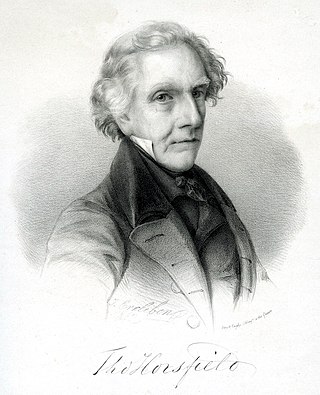
Thomas Horsfield was an American physician and naturalist who worked extensively in Indonesia, describing numerous species of plants and animals from the region. He was later a curator of the East India Company Museum in London.

Bogor City or Bogor is a city in the West Java province, Indonesia. Located around 60 kilometers (37 mi) south of the national capital of Jakarta, Bogor is the 6th largest city in the Jakarta metropolitan area and the 14th overall nationwide. The city covers an area of 111.39 km2, and it had a population of 950,334 in the 2010 Census and 1,043,070 in the 2020 Census. The official estimate as at the end of 2023 was 1,127,408. Bogor is an important economic, scientific, cultural, and tourist center, as well as a mountain resort.
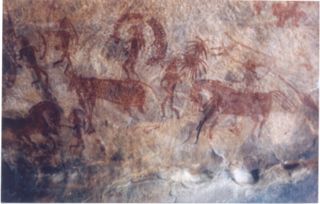
Natural history in the Indian subcontinent has a long heritage with a recorded history going back to the Vedic era. Natural history research in early times included the broad fields of palaeontology, zoology and botany. These studies would today be considered under field of ecology but in former times, such research was undertaken mainly by amateurs, often physicians, civil servants and army officers.

The Museu Paraense Emílio Goeldi, commonly shortened MPEG, is a Brazilian research institution and museum located in the city of Belém, state of Pará, Brazil. It was founded in 1866 by Domingos Soares Ferreira Penna as the Pará Museum of Natural History and Ethnography, and was later named in honor of Swiss naturalist Émil August Goeldi, who reorganized the institution and was its director from 1894 to 1905. It is now the "main research center on natural systems and sociocultural processes of the Brazilian Amazon." The museum and zoological park are listed as protected sites by both the National Institute of Historic and Artistic Heritage, and the Department of Historic, Artistic and Cultural Heritage of the state of Pará.
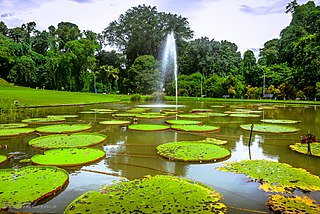
The Bogor Botanical Gardens is a botanical garden located in Bogor, Indonesia, 60 km south of central Jakarta. It is currently operated by the National Research and Innovation Agency. The garden is located in the city center and adjoin the presidential palace compound of Istana Bogor. It covers an area of 87 hectares and contains 13,983 different kinds of trees and plants of various origin. The geographic position of Bogor means it rains almost daily, even in the dry season. This makes the garden an advantageous location for the cultivation of tropical plants.
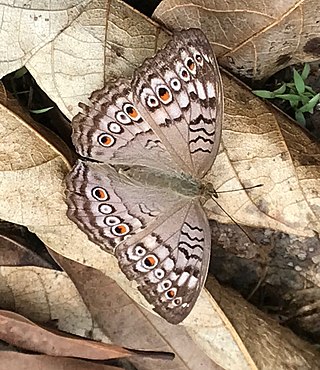
Junonia atlites, the grey pansy, is a species of nymphalid butterfly found in South Asia.

Nepenthes × hookeriana, or Hooker's pitcher-plant, is a common natural hybrid involving N. ampullaria and N. rafflesiana. It was originally described as a species.

The crab-eating frog is a frog native to south-eastern Asia including Taiwan, China, Sumatra in Indonesia, the Philippines and more rarely as far west as Orissa in India. It has also been introduced to Guam, most likely from Taiwan. It inhabits mangrove swamps and marshes and is one of 144 known modern amphibians which can tolerate brief excursions into seawater, and is possibly the only extant marine amphibian.
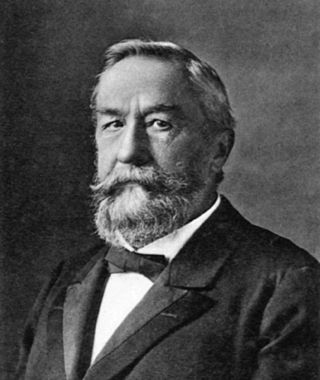
Gustav L. Mayr was an Austrian entomologist and professor in Budapest and Vienna. He specialised in Hymenoptera, being particularly known for his studies of ants.

The Copenhagen Zoological Museum was a separate zoological museum in Copenhagen, Denmark. It is now a part of the Natural History Museum of Denmark, which is affiliated with the University of Copenhagen. The separate museum location closed in 2022, but will reopen in 2025 in new and considerably larger buildings in the northeastern corner of the Copenhagen Botanical Garden. Although the museum will be relocated, the research and storage facilities at its old location have been maintained.
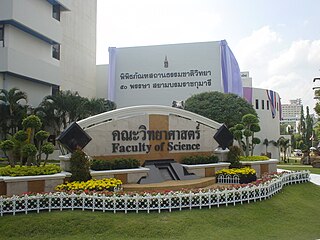
The Princess Maha Chakri Sirindhorn Natural History Museum is a natural history museum in the Prince of Songkla University in southern Thailand. It was originally known as the Natural History Museum of Prince of Songkla University (PSU Museum). After a renovation, it was renamed and re-opened on 14 January 2008 by HRH Princess Maha Chakri Sirindhorn. The museum's main building is located in the most west part of the Faculty of Science. The building contains both exhibition and collection areas.
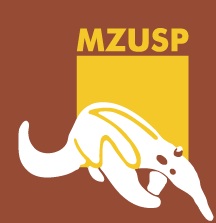
The Museum of Zoology of the University of São Paulo is a public natural history museum located in the historic Ipiranga district of São Paulo, Brazil. The MZUSP is an educational and research institution that is part of the University of São Paulo. The museum began at the end of the 19th century as part of the Museu Paulista; in 1941, it moved into a dedicated building. In 1969 the museum became a part of the University of São Paulo, receiving its current name.

The Ministry of Health is a government ministry which organize public health affairs within the Indonesian government.
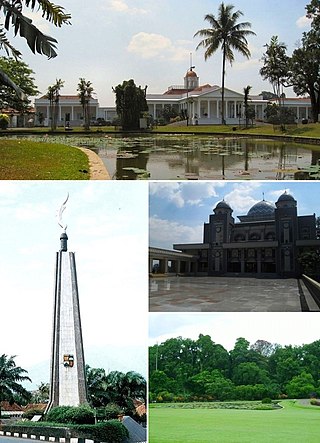
The History of Bogor includes various rulers leading up to the development of the densely populated Indonesian city of Bogor. The City of Bogor was once the capital of Sunda Kingdom and was known as Pakuan Pajajaranknown. When the Dutch took over, the town was included in an administrative division known as Buitenzorg during the Dutch East Indies era. After independence, the city became part of the Bogor Regency. It has its history reflected in its architecture which includes buildings from the colonial, modern, post-modern, and contemporary periods. Bogor is located south of Jakarta on the island of Java, Indonesia. It is known for its Bogor Palace, Bogor Botanical Garden.
Jacobus van der Vecht, nicknamed Jaap, was a Dutch entomologist who specialised in Hymenoptera, especially those of the East Indies and New Guinea.

Djunijanti Peggie is an entomologist who specializes in Lepidoptera of Indonesia. She is a researcher and curator for the Indonesian Institute of Sciences. Peggie is the first Indonesian to become a butterfly researcher and author of books about butterflies. She is considered to be the mother of Indonesian butterfly studies.

The Indonesian Agency for Agricultural Research and Development(Indonesian: Badan Penelitian dan Pengembangan Pertanian, abbreviated as Balitbangtan) abbreviated in English as IAARD was a supporting unit of the Ministry of Agriculture which is responsible for state research, development, and innovation in the field of agriculture in Indonesia.

The National Institute of Health Research and Development was a supporting unit of the Ministry of Health which is responsible for state research, development, and innovation in the field of health and medical sciences. The agency dissolved and liquidated into National Research and Innovation Agency (BRIN) on 31 December 2021 as part of BRIN state research activity integration plan.

The Forest and Environment Research, Development and Innovation Agency, officially named Research, Development, and Innovation Agency of the Ministry of Environment and Forestry. The agency nationally known as BLI, while internationally known as FORDA-MOF. The agency was a supporting unit of the Ministry of Environment and Forestry. The agency was responsible for performing researches on environmental sciences, climate change and its mitigation, and forestry in Indonesia.
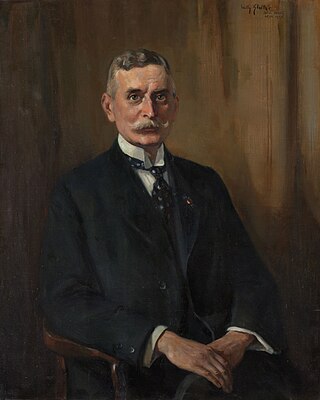
Jacob Christiaan Koningsberger was a Dutch biologist and politician. He spent much of his life in the Dutch East Indies, where he wrote extensively about the flora and fauna of Java. He was extensively involved in the Lands Plantentuin in Buitenzorg, serving as its director between 1910 and 1918. In politics, he served as the first chairman of the Volksraad (1918–1919), as well as Minister of the Colonies under Dirk Jan de Geer (1926–1929). An independent, he had liberal leanings and allowed more indigenous representation in governance.






















